![]() March-April 1999
March-April 1999
Illustrations by Bill Basso
Congratulations to all who entered Scouting magazine's "Seeing America" essay contest. Readers were challenged to describe an exciting, colorful, fascinating, or otherwise totally remarkable location visited by a Cub Scout, Boy Scout, or Venturing unit.
Most entries were by adult Scout leaders, although some youth members also submitted essays. The variety of experiences ranged from a visit to a neighborhood convenience store to a trip to the Alaskan wilderness to a tour of a municipal landfill site to a solemn visit to a national military cemetery.
Prizes were BSA Supply Division gift certificates: First - $300; Second - $200; Third - $100; Honorable Mention - $25.
Note: Details of Scouting magazine's next reader competition, our biennial photography contest, will be announced in the May-June issue.

Troop 229's destination for summer camp in 1998 was the Blue Ridge Mountains Council's High Knoll Trail high adventure program. To make the most of our 900-mile journey from Florida to the mountains of Virginia, we scheduled a side trip to Virginia Tech University in Blacksburg.
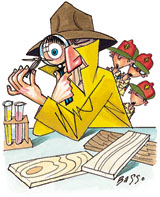
An alumnus of Virginia Tech, I arranged for our Scouts to work on the Forestry merit badge with a professor I had studied under some 20 years earlier, Dr. Mark White.
We arrived at Virginia Tech's Brooks Forest Products Lab at 9 a.m. I renewed some old acquaintances, then found Dr. White. He led our group of 16 to a classroom. There, he not only taught basic forestry concepts but livened up his discussion with fascinating anecdotes that took the subject to a completely different level.
Rather than a dry subject, forestry had uses the Scouts had never imagined.
We learned that Dr. White had played an important role in gathering key evidence against the Unabomber, Ted Kaczynski.
Each bomb sent to a victim had been crafted inside a handmade wooden box. And although the box was destroyed in the explosion, small splinters or fragments always remained.
The F.B.I. sought out Dr. White, one of the world's leading wood technologists, to see what he could tell them about the wood. Dr. White agreed to help but insisted that, until the Unabomber was caught, his identity be kept secret. The reason? University professors were a favorite target of the Unabomber (una in his F.B.I. code name was short for university). Dr. Wood also asked that all his mail be inspected, since this was how the bombs were delivered to the victims.
Once these safeguards were in place, Dr. White began his work. From the bomb fragments, he determined the species of wood used in their construction. He also established that several bombs came from the same piece of wood.
All this from splinters! After Kaczynski was apprehended, Dr. White examined wood found at the Unabomber's Montana cabin and discovered it was used in making the bombs. Furthermore, tools found with the wood had distinctive wear marks that matched those left on the wood components of the bombs.
When confronted with this conclusive evidence linking him to the bombs, Kaczynski pleaded guilty to the charges against him.
A victory for the science of forestry and the good guys! And a lesson for our Scouts that no matter how tame a subject may appear, there is always more to it than first imagined.
Ken Brighton
Assistant Scoutmaster, Troop 229
Deerfield Beach, Fla.

It was going to be a normal Tiger Cub den meeting (if there is such a thing). From one Tiger Cub's home, we were going to walk to a nearby convenience store; there the boys would use a pay telephone to place a call to their home or another important number.
On the way, the boys enjoyed being together, checking out bugs, trees, and plants, and didn't seem to mind our constant reminders to stay together, walk on the sidewalk, and not run!
Then we noticed a car with a flat tire driving slowly toward the convenience store. We talked about what we could do if that happened to us while driving. Then a police car drove by. This, of course, caught everyone's attention, and the boys waved at the officer.
At the store, we started our "pay telephone training." This sounds simple, but it was a new experience for the Tiger Cubs. Does everyone have his phone numbers memorized? Where do you put the quarter? Can you find the numbers on the keypad?
What do you do if an answering machine answers? And how would you call 911 in an emergency?
As we continued making our calls, we noticed the car with the flat tire parked nearby. An elderly woman got out to make a phone call. Our adult Tiger Cub partners asked if we could help - and proceeded to involve the Tiger Cubs in an all-out effort to assist the woman.
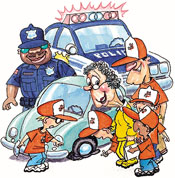
The police car pulled up, and the officer joined the effort. What a sight - Tiger Cubs and their adult partners together with a local police officer helping an elderly woman with her car. How proud we were - not only to see this but to realize that it was an automatic reaction - helping someone in need. (How often today do people look the other way?)
After the task was finished, the police officer came over to thank our group. He then spent some time talking to the Tiger Cubs about helping others and safety while walking (always walk with a buddy, stay on the sidewalk, don't talk to strangers).
He showed both patience and willingness to answer an endless stream of questions from the inquisitive Tiger Cubs. He let the boys look inside his patrol car and handed each of them several football trading cards that he carried in the car. He gave the adult partners his business card and invited everyone to come by the police station for a tour.
On the walk back to the house, the boys had endless questions about emergency situations, changing flat tires, and being a policeman, among others. They were also very proud that they had helped someone in need. What a good feeling!
We hadn't visited a historical site or other exciting location. We just took a walk in our neighborhood - but what a walk it was.
In one hour the boys learned so much about safety, respect for nature, helping those in need, community services, and using public facilities. They witnessed role models in action, with their adult partners working alongside a police officer.
And that's what Scouting is all about - working together to learn about the world and to help other people.
Lori Harding
Tiger Cub Coach, Pack 114
Sunrise, Fla.

Troop 250 has impressed the public wherever we have gone. At meal stops, we often hear comments on our appearance and manners.
However, during a trip to the caves of southern Indiana and Kentucky, our Scouts were the ones being impressed at mealtime.
The caves were magnificent, with many breathtaking sights, but the sharpest memories came from, of all places, the mess hall at Fort Knox, Ky., where we ate dinner and breakfast.
We briefed the Scouts that there should be no conversation in the mess hall, they should stay together at our assigned tables, take only what they could eat, and eat everything they took - and we had only 20 minutes to eat and return our trays.
No problem, they nodded. But nothing could have prepared them for the sights and sounds of real drill sergeants working with real recruits. What a contrast between their usual fast-food world and the rigid discipline of military basic training. Indeed, the experience left the boys momentarily speechless!
Each Scout saw and remembered a different snippet of that very energetic and efficient operation. A few Scouts can tell you how good the food was, but not many. Most focused on the people around them, like the hapless recruit who failed to move along the line at the proper speed. His drill sergeant delivered a brusque reminder, about two inches from his nose.
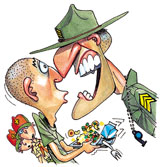
Another recruit dropped a fork and was rewarded with a sergeant's quick, loud lecture comparing him (poorly) to our Scouts. The overwhelming impression was of the lines of men, each individual precisely so far apart from the next, ID card held at chest level, silent and moving in unison.
In the serving area, they silently loaded their trays and sat down quickly to eat. The dining area was large, but only the faint clink of flatware and china marked how fast and how hungrily the hundreds of recruits consumed their meal.
Each platoon finished within the 20 minutes, bused their trays, and departed, to be replaced by another platoon. Only the hoarse voices of the drill sergeants were heard, growling orders and corrections, giving no quarter, and granting no leeway.
Each recruit spoken to replied in the same words: "Yes, sir, Drill Sergeant, sir." The whole experience was less a meal than a military operation.
Each Scout stood a little straighter, ate a little faster, and tried a little harder to be a "man in uniform" and copy the young men they were quickly learning to respect.
Yes, we were fed well (and cheaply), but the lessons in obedience and precision were priceless. The Scouts had walked to the dining hall as a ragtag group, but they marched back to the bus as a proud, uniformed unit.
Kim Pitsch
Assistant Scoutmaster, Troop 250
Byron Center, Mich.

I was a new Cub Scout leader the year my son, Daniel, was a Bear Cub Scout, and the school year was almost over before my assistant and I got up the nerve to take the den on a field trip.
To fulfill one of the "Take Care of Your Planet" requirements, we decided to visit our local landfill. The boys agreed it would be fun to see all the trash.
The morning of our trip was also trash pickup day on our street. In the garbage cans I carried to the curb was an orange cushion that had fallen victim to our new puppy's gnawing teeth.
After school we headed to the landfill, where the boys were fascinated with the huge machinery used to move and bury trash. Our guide showed us spots where different items, like tires, oil, and appliances, went to be recycled. We saw pipes in which methane gas was collected, to use for a source of power at the landfill.
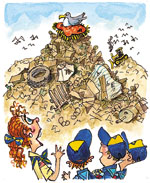
To see what happened to the tons of trash delivered each day, we watched tractors burying recent arrivals. Then, as we turned to walk back to the office, we spotted a familiar orange cushion. It was the chewed up one we had just thrown out.
My son recognized it immediately, and I pointed it out to the other boys. I told our guide how we had tossed the pillow that very morning. She laughed and said, "I have had a lot of people tour the landfill before, but I never had anyone who could identify his own trash!"
Seeing the cushion helped bring home to the boys how connected the trash cycle is. We always assumed that what we threw out just went away.
At the landfill, however, we saw that although trash leaves our home, it has to end up somewhere.
Because of that lesson, the boys became real advocates of recycling and keeping trash in its place. They have helped several years at our Green Up Day activities, and now, as Boy Scouts, they clean up the local trails in the town forest as an annual project.
And whenever I put out something unusual for the sanitation crew to haul away, I remember the ill-fated pillow. It had served as a signpost for my den, pointing us in the direction of conservation.
Mary Anne Deer
Assistant Cubmaster, Pack 412
Vernon, Vt.

Den 1 was lucky enough to have reserved a local radio station's one monthly tour. At first, however, it looked as if the day's biggest attraction might be the radio station's revolving door and subsequent 19-floor elevator ride. Disaster seemed imminent as the Cub Scouts clowned around in the station's reception area.
Within 10 minutes, however, the boys had become mesmerized by the electronic wizardry and pace of Hartford's WTIC AM/FM.
Our tour guide was Maria, an advertising executive who had the gift of being able to see through the boy's shenanigans. She also knew that they would find a kindred spirit in Damon Scott, one of the station's on-air personalities - and, coincidentally, a Cub Scout parent.
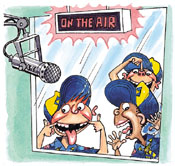
Damon grabbed their attention immediately by making funny faces through the broadcast booth window at a DJ who was on the air. Of course, the Cub Scouts did likewise, leaving mouth and nose prints all over the glass.
Knowing that the Cub Scouts craved flash and pizzazz, Damon crammed 10 boys and three adults into a production booth and recorded each boy's voice into a computer.
Using the audio equivalent of a word processor, the voices were woven into a funky background beat. The boys embellished the final version by adding sound effects and a variety of "creative noises." After 15 minutes of fun, Den 1 had completed a genuine promotional tape!
Throughout the session, Matt M. could hardly contain himself. "I want to have your job, Mr. Scott!" he exclaimed. "How can I get a job like yours?"
We toured the newsroom and sales offices and ended up on the AM side of the station. Colin McEnroe, co-host of an afternoon talk show, gave the den (and their elementary school) a few moments of glory on the air - although the Cub Scouts didn't quite comprehend that they had just been broadcast over a 50,000-watt radio station.
Back on the FM side, our friend Damon Scott had started his show, and the 13 of us stuffed into his booth. In between his announcing duties, he showed the boys how to create a two-person comedy skit, using a recording of himself as the second person. Then he had the den record, in classic Cub Scout fashion, a loud cheer for the traffic reporter.
The tour was almost over when we heard Maria shriek, "No, not there!!"
It turned out the boys were about to check out the office of the big boss.
Maybe they were getting ideas for the future.
Rick Liftig
Committee Chairman, Pack 161
West Hartford, Conn.

On an outing to my family's cabin in Big Bear, Calif., the Cub Scouts of Pack 207 asked a neighbor if they could borrow a rake. The neighbor lent us the rake and then began instructing us in the proper way to rake leaves.
Joe, one of the Cub Scouts, asked: "What are you? A rocket scientist or something?" Imagine our surprise when he answered, "Well, yes, in fact, I am." He was Dr. Richard Stoller, from the Jet Propulsion Laboratory (JPL) in Pasadena, Calif.
Cubmaster Bo Macaraeg then asked if the Scouts could tour the lab sometime. Dr. Stoller, who has two sons in Boy Scouts, was more than happy to accommodate us. The two men discussed arrangements over the next month or so, and then the invitation was extended to the entire fifth-grade class at our school, Holy Family.
Our fifth-grade teacher, Miss Cala, wasn't sure how excited she was about taking the entire fifth grade on such a long, expensive trip. However, the necessary funds were raised; a bus arranged for the day; parent chaperons enlisted; and permission slips passed out, signed, and returned. And away we went on a 12-hour trip to the JPL.
When we pulled into the lab entrance, we were not allowed to leave the bus until Dr. Stoller came to the security booth and signed us in.
Needless to say, security was strict. Although we were allowed to eat our sack lunches in an outdoor area, we were given strict orders not to leave the area without Dr. Stoller.
For lunchtime entertainment, the Cub Scouts performed the "invisible bench skit" for the rest of the fifth-grade class.
Dr. Stoller is the spacecraft systems engineer of the Cassini Project. (The Cassini spacecraft was launched in October 1997 and is scheduled to reach Saturn in 2004.)
Dr. Stoller gave a presentation on the outer planets. We watched a 22-minute film depicting several JPL projects and photographs of Jupiter's storms, Mars's barren landscapes, and Saturn's rings. We were also able to see the Cassini spacecraft and the Martian rover being built. Dr. Stoller then stood before a full-size model of one of the Voyager spacecrafts, another space vehicle he has worked on, and spoke about his work.
The trip highlight was when we all signed our names to the list of "Friends of Cassini." The list was optically scanned, digitized, entered on CD-ROM, and mounted on the Cassini spacecraft. "By participating, we will become involved in a part of the future and, ultimately, share in a piece of history," Miss Cala said.
We ended the tour at the Flight Operations Center, where we learned about the Galileo spacecraft. Dr. Stoller recognized each Scout with a signed letter, a patch, and a Cassini sticker. Cubmaster Bo called the field trip "an educational and fun-filled event." It was also a memorable, once-in-a-lifetime field trip!
Aaron Lanzer
First Class Scout
San Diego, Calif.

New York City has its great and difficult moments; these join sometimes at precious points as bittersweet indicators of how things might be better in the future.
Scouts were celebrating the formation of our new Troop 153, with participation in a health and safety fair, where we were seeking local support for a hike-a-thon. The boys had exciting opportunities to meet members of the Jets professional football team and to speak with volunteer ambulance corps members about their activities. The New York City Fire Department was speaking about fire safety in the home and auxiliary police were providing fingerprinting to visitors. It was an interesting day topped by hot dogs, soda, and ice cream.
We organized to make good on our pledges obtained for the hike-a-thon. We intended to bring attention to the new unit, doing a route on the main street going through our home community.
A truck from the local firehouse was moving swiftly down the street and slowed as it neared us. The captain jumped out of the truck, and approached our group of about a dozen uniformed Cub and Boy Scouts. The captain explained that they had been invited to the fair, but they were called away to provide coverage elsewhere.
News blanketing the city at the moment described an earlier large and terrible fire, and sadly, the death of a firefighter and severe burning of several other firemen as they were searching a building on reports of a trapped resident.
The firemen were quickly tumbling out of the truck, for the captain had invited them out to demonstrate to the boys the safety equipment on the truck, a pumper carrying its own supply of water. With one fireman putting on all of his heavy equipment, they demonstrated some new devise that would flash and provide an audible signal if the person wearing the equipment was not moving. The description resounded with importance in light of the current news.
The captain spoke with one of the crew, and then proposed to us an opportunity for the youth to use the firehose! The boys listened carefully to instructions, and patiently waited their turn to be the lead "fireman" on the hose. One by one, each youth took a turn enjoying the experience of a New York City lifetime, granted them because we were wearing the uniforms of the Boy Scouts of America.
I was amazed in watching the tenderness of these men teaching boys, all the while listening to tragic department broadcasts on their truck radio and grieving for their coworkers, commenting quietly to each other about details. For now, these youth are protected from some of the sadder elements of life, but the bittersweet nature of the sharing among the firefighters underscored to me the importance of all the lessons I had myself taught many of these boys, as they grew from Tigers to Scouts. They will learn further one day about such men who enter fires to save lives, no matter what the danger or cost, using all of the skills available to them through training ... some no doubt, trained as young Scouts to later undertake careers of service. Scouting this day provided another way to see the America to be, knowing the probable outcome of the Scouting program for many of these youth. It was an unexpected but remarkable day spent seeing the America of today in the spirit of these firefighters and in the excitement of the Scouts they stopped on an ordinary street.
Tom McGlinchey
Committee Chairperson
Troop 153

[As part of gathering our essay information, we arranged one activity for the Webelos Scouts from Den 46 to participate in the process. We asked each boy to write a paragraph which described a highlight of the trip to Mount St. Helens that they would like to share with other Scouts around the country. These 10 and 11 year old Scouts from Den 46 are as follows: Brad Basal, J.J. Deal, Jonas Jonsson, Matt Leigh, Nick Parker, Justin Pay, Hunter Ross, Michael Williamson.]
Imagine!
The earth trembles. Sounds echo. Temperatures rise. Hold onto something - anything! A billowy gray cloud of ash, a tidal wave of trees, an avalanche of mud, rock, and ice heading towards you ...
Movies?
No - worse - the true story of Mount St. Helens. On May 18, 1980 it really happened. The volcano blew apart with a blast equal to a 10 megaton atomic bomb. The Webelos Scouts from Den 6 viewed this Cinedome reenactment.
In August 1998, eight Scout families from Bellevue, Washington trekked to this volcano in their backyard-only two hours drive away to Johnston Ridge for reach-out-and-touch views of the crater. Planning the trip took much longer! With helicopter rides, Ape Cave exploration to follow, and a drive to Windy Ridge for blast zone views, the question was-how to pay for all this adventure?
"A garage sale?!" The group agreed. An ad was placed 'Eight Families Clean House', minivans arrived, three garages filled to overflowing. Some Scouts priced and arranged. Others took charge of cashiering and cleanup while leaders counted cash and carted remaining goods to charity. The boys voted to donate funds to Friends of Scouting to send a Scout to camp. Nick Parker explained, "We calculated everything; we earned $2,083."
Hallelujah, helicopters! Four Scouts squeezed into the tiny Bell Jet Ranger for their 30 minute flight. "CHOP, CHOP, CHOP," Michael Williamson sputtered to simulate the sound of take-off.
"We flew right over the blasted out crater. I could see little steam holes," cried Brad Basal.
Afterward, "What a blast!" J.J. Deal yelled racing off the landing pad.
Ape Caves next. "Bundle up!" Scouts were told, it's a constant 42%. Others lit lanterns; there's no outside light in the 1900-year-old lava tube boasted as one of the longest in the United States. Inside, everyone could stand up since the tube is train-tunnel size. Scouts stumbled in the dark over rippled lava formations and broken black chunks. Snake-like bends widened or narrowed as lantern reflected eerily on distorted rock outcroppings. The hike, Justin Pay claimed, "...was so far, I can't even tell you how far!" Really, the cave measures 12,810 feet.
The caravan continued along award-winning routes to the spectacular vistas of Windy Ridge. ". . . it was really, really windy," Hunter Ross remarked, " . . .we Counted 429 steps to the top." Everywhere, shattered tree trunks looked like giant toothpicks. A car, turned rusty with age, plopped among pink wildflowers. During the blast it had been flung from one side of the road to the other. It belonged to a miner; he didn't make it out.
Rectangular patches of green forest-evidence of recovery-stitched the gray moonscape mountain together, though the devastation remains visible 18 years later.
Will Mount St. Helens keep quiet-445 earthquakes in July alone?
"Hey Matt, did you feel that?" Scout Jonsson whispered.
"Feel what?" replied Scout Leigh.
"That tremble in the ground ... ?"
Lynne Deal
Den Leader
Pack 435

Starting out in September as a first year Cub Scout Leader and trying to keep with the monthly theme, we needed to discover the importance of Our Town! Our first den meeting was also our first field trip. Keeping in mind that Outing is in Scouting, we were to discover who our Elementary School was named after, Richard Ira Bong - Ace of Aces.
The boys were asked if they knew who Dick Bong was. Many knew he was in a war, flew a plane that crashed and died. But that still did not answer who was Richard Ira Bong - Ace of Aces, who's plane was in our school drive on display for all to see and now it is gone, and to where?
Few knew about his accomplishments and for this information we invited his sister Joyce to speak to us. She had a video of actual footage of his life in Poplar with his family - to show what it was like in the days of Dick Bong. She explained how he was much like the Cub Scouts sitting there and listening to her. As a child he did much of the same things kids do now for fun. The boys were glued to the film footage of an aerial dogfight and how a quiet country boy would come home and be with his family after such a emotional tour. They were able to see many historical and memorable events where Dick Bong was presented medals and other honors. They also were able to see how people during the war had to face agony on a day to day basis. This experience was also an excellent example of how a small town person can do big things in the world to help improve it and help make the place you live more extraordinary. Small town people are proud of their own!
We learned of a new museum being built for the plane which is being repaired due to weathering from being outside for years.
We then walked from the cafeteria of our school through the gym to the Memorial Room which is the present Dick Bong Museum. We were able to see actual items that were Dick's and what the new museum is to look like. No tour permit required as the parents walked along too. Talk about KISMIF!
Brenda Deterling
Den Leader
Pack 212

As my Safari Van, loaded with Webelos, climbed the road up the hill to the Leslie Science Center, on fifty acres in the city of Ann Arbor for our scheduled sleepover, I couldn't help but think, it just looks like an old house....
How could our nine Webelos possibly earn their NATURALIST pins and learn to LOVE NATURE HERE??? But, as we entered the evening and our guides Michelle and James began to unfold their program, the NATURALIST in each of our boys began to emerge!
How can a boy NOT fall in love with nature when a coiled Massassagua Rattler is placed on the rug right in front of him? (Frozen! They could even touch it!) How can a boy NOT fall in love with nature when he's actually HOLDING poison ivy in his own hands to learn to identify it? (Don't worry, Mom, it was in a glass frame!) And, how can a boy NOT fall in love with nature as he enters the mysterious world of forest creatures in the dark of night, using only his "night eyes" and the light of the moon to follow his Webelos buddies hiking the path through the trees and over logs in the direction of the croaking and beckoning chorus of frogs hiding in the pond under the stars?
It's impossible for excited boys to stay quiet when sprawled everywhere across the wooden bridge on their stomachs, hanging down the sides, while salamanders and eggs, wood frogs, spring peepers, water spiders, fairy nymphs, and water boatmen are scurrying in the pond to be caught with nets and cottage cheese containers and examined with flashlights!
Did you ever pause silently in the forest at night with a Webelos and observe a hawk's lonely nest with babies in it, silhouetted high in a tree, waiting for the mother to return from flight?
Or watch their faces glowing brighter than the flames of the roaring campfire as the master storytelling captivates them, creating a memory that the hottest video games will NEVER TOUCH!
As the lights in the city below us began to twinkle out, so did the boys in their sleeping bags! The chorus of frogs faded into the deep night until the first rays of sunlight brought new songs - waking birds, and waking boys! A light breakfast, and a morning hike to burn off energy revealed a whole NEW forest of life and excitement. EVERY SCOUT in his lifetime should experience the "Critter House", where CRITTERS are allowed to crawl on YOU, captivating our time as activities and knowledge swirled around us!
Before we knew it, my Safari Van, loaded with Webelos, crawled down the road of the hill towards home. I couldn't help but think, HOW COULD ANYONE visit the Leslie Science Center, with it's fifty acres of woods, prairie, meadows, and ponds, it's INCREDIBLE staff, and NOT FALL IN LOVE WITH NATURE???
Chris Jakel
Webelos Leader
Pack 247
| The Boy Scouts of America | http://www.scouting.org |